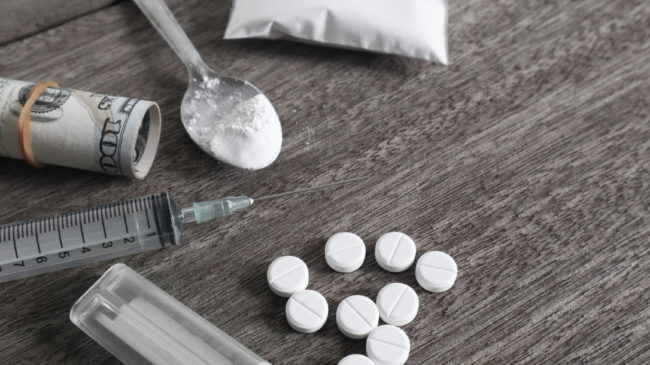Oregon Measure 110 – Drug Addiction Treatment and Recovery Act
Summary:
Oregon’s Measure 110 would remove criminal penalties for individuals caught in unauthorized possession of any Schedule I, II, III, or IV controlled substance in amounts reflecting personal use and instead would impose a maximum fine of $100. It would also redirect a portion of marijuana excise tax revenues to finance treatment for individuals addicted to drugs and for harm reduction measures, such as the distribution of sterile syringes and naloxone hydrochloride, a drug that can treat opioid overdoses.
Fiscal Impact:
Measure 110 does not create new tax instruments, but it diverts substantial amounts of revenue from marijuana excise taxes away from current recipients. Any quarterly marijuana tax revenue in excess of $11,250,000 would be diverted to the new Drug Treatment and Recovery Services Fund (DTRSF) to finance grants to community organizations approved to provide drug addiction treatment and related services. In quarter four of fiscal year 2020 (April to June), state marijuana tax receipts amounted to $40,489,897. If Measure 110 had been effective for this fiscal quarter, $29,239,897 would have been diverted from existing recipients to the Drug Treatment and Recovery Services Fund. Under current Oregon law, marijuana tax revenues are allocated in the following proportions:
- 40 percent to public schools
- 20 percent to cities and towns in proportion to their population and concentration of licensed marijuana businesses
- 20 percent for mental health services
- 15 percent for state police
- 5 percent for alcohol and drug abuse prevention
These pro-rata shares would remain intact if Measure 110 passes, but would become subject to the quarterly cap of $11,250,000, implying a substantial and immediate reduction in the tax allocation for these purposes.
In addition, Measure 110 requires the Legislative Assembly to appropriate a minimum of $57 million annually to the DTRSF, to be adjusted upward in subsequent years by at least the rate of inflation. Although Measure 110 does not specify the source of this appropriation, it should be assumed these funds would be appropriated from the state’s General Fund, which would proportionately reduce funds available for other purposes.
Further, Measure 110 instructs the Department of Revenue to calculate how much money Oregon has saved over the course of each biennium by not arresting, incarcerating or supervising individuals in possession of controlled substances for personal use. The resulting savings also would be deposited into the DTRSF. The Department is instructed to calculate these savings based on a comparison to the prior biennium, which implies that the calculated savings should decline over time as fewer individuals are arrested. However, Measure 110 also contains a hold-harmless provision stipulating that the Department must always credit to the Drug Treatment and Recovery Services Fund at least “the highest amount calculated for any previous biennium.”
Once funds are deposited into the DTRSF, they remain continuously appropriated and not subject to reversion at the end of a budget cycle. This means the DTRSF is protected from the normal process facing most state agencies, which see their balances revert to the state’s General Fund at the end of a fiscal year and then have new funds appropriated for the ensuing year. Funds can never be swept from the DTRSF.
Proponents’ Arguments For:
The War on Drugs has been costly in terms of both lives and dollars. Drug addiction is a mental health disorder best treated with therapy, whereas incarcerating individuals for drug use does little to address the underlying health conditions. Proponents note that one-in-11 Oregonians suffer from drug addiction and Oregon has among the fewest drug addiction treatment facilities in the United States.
Measure 110 would not legalize any drugs, it would simply direct individuals found in possession of drugs to a treatment facility rather than prison. Supporters say that this would allow people to turn their lives around through comprehensive, evidence-based treatments while also freeing up law enforcement to pursue more serious and violent crimes. The measure doesn’t create any new taxes and could also prevent unnecessary deaths through harm reduction policies like distribution of sterile syringes and the potentially life-saving overdose treatment naloxone hydrochloride.
Opponents’ Arguments Against:
There is not currently an organized opposition to Measure 110. However, the Washington County District Attorney says Measure 110 is a “terrible idea’ that would lead to increased crime and drug use. And one doctor who treats drug-addicted patients has stated that people with active addictions are not rational actors who seek out and accept treatment, that Measure 110’s small fines will not coax people into recovery, and that “removing the threat of incarceration and abandoning the collaboration between law enforcement, the judiciary, probation, and the drug court system will result in a revolving door of drug abuse, treatment refusal, crime, homelessness, and ongoing costly health-related expenditures for hospitalizations due to overdose, infections, and drug-induced psychosis.”
Discussion:
Oregon’s Measure 110 intends to curtail drug abuse through four approaches:
- Patient-centered treatment, including through addiction recovery centers that offer 24-hour triage centers to meet with patients and enroll them into an evidence-based recovery program;
- Peer support and recovery services to maintain contact with each patient, monitor their progress and sobriety, and provide mentorship;
- Transitional housing for drug-addicted patients who need to get off the street and find employment; and
- Harm-reduction interventions to ensure drug use does not result in avoidable deaths or the spread of disease.
A preponderance of academic studies indicates “there is sufficient evidence to support the wide‐spread adoption of harm reduction interventions and to use harm reduction as an overarching policy approach in relation to illicit drugs.” These studies find that treatment and harm reduction strategies are more effective at dissuading dangerous drug use than alternative approaches, including strict prohibition.
Oregon would become the first state in the nation to decriminalize all drugs (which is not legalization) if Measure 110 is approved. However, the policies that Measure 110 would enact closely mirror the approach taken in Portugal beginning in 2000. A 2015 study in the International Journal of Drug Policy found that these changes in Portugal reduced the social cost of drug use by 18 percent during its first 11 years. Overdose deaths have fallen by 80 percent while the prevalence of new HIV/AIDS patients who used drugs fell from 52 percent to just 6 percent in the country. Although usage rates have not fallen, Portugal’s experiment has been a success by most other measures.
Measure 110 specifies certain possession limits that reflect personal-use amounts. Possession of any amount above those limits would be interpreted as either criminal possession or the commercial manufacture or distribution of controlled substances, which would both remain a crime. The personal-use limits specified in Measure 110 are as follows for particular substances:
- LSD, methadone, oxycodone: 40 units
- Psilocybin: 12g
- Heroin: 1g
- Cocaine, methamphetamine: 2g
In the interest of helping current and former addicts gain employment and turn their lives around, Measure 110 would create a rebuttable presumption that existing or prior possession convictions cannot preclude a licensing agency from issuing an occupational license that would be required to gain a job in certain industries, such as landscaping or cosmetology. This is an important change more states are making and studies show that easing licensing restriction on those with criminal records reduces recidivism and boosts the economy.
Despite the empirical promise of treatment and harm-reduction approaches in Measure 110, it creates some challenging fiscal impacts. Practically speaking, the transfers of calculated savings from the Department of Revenue may prove difficult because adequate surplus revenues may not be available after a fiscal biennium has concluded. Legislative appropriations to state agencies such as state police or corrections departments tend to decline over time in response to reductions in actual spending. For instance, if a reduction in drug enforcement allows the Department of Corrections to reduce its spending by 30 percent in the first biennium after Measure 110 becomes effective, then legislators are likely to respond by proposing about a 30 percent reduction in spending to that agency in the ensuing biennium with the expectation the savings will be ongoing. As a result, the agency will have fewer available dollars to revert to the Department of Revenue at the close of the biennium and the Department of Revenue could then have insufficient funds to make a post-biennial transfer to the DTRSF. In practice, funding allocations that occur after the close of a fiscal cycle are difficult to administer.
Voters’ Guide to Other Marijuana Legalization and Drug Policy 2020 Ballot Initiatives
Voters’ Guides to 2020 Ballot Initiatives on Other Policy Topics

